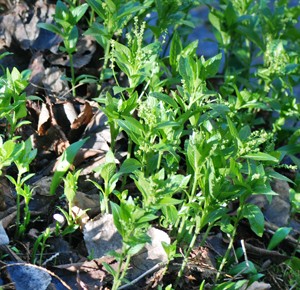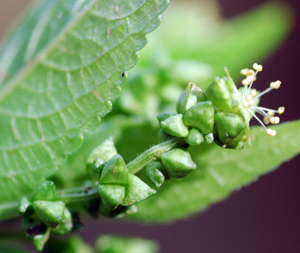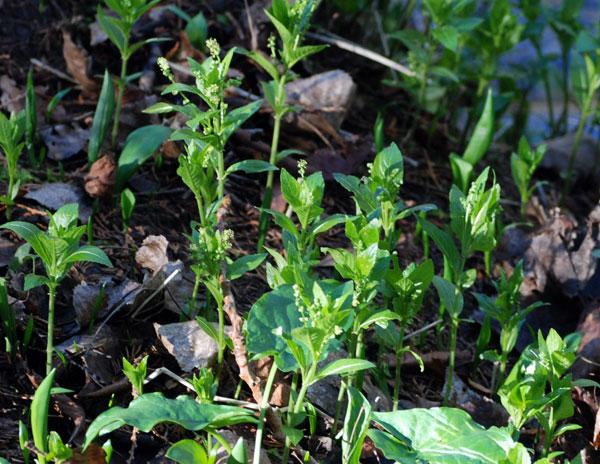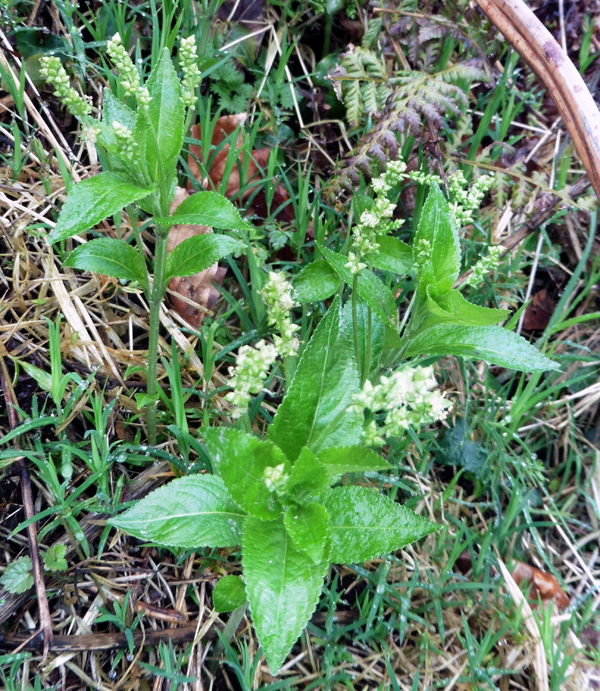Dog’s mercury

Dog’s Mercury (Mecurialis perennis) is sometimes referred to as ‘dog’s cole’. It is a perennial and is found in woodlands (particularly beech and oak); and in shady places (like dense hedgerows); it is found widely throughout Britain (except Northern Scotland). Its distribution in Ireland is much more limited.
It can spread by means of its underground rhizomes (stem-like structures that penetrate through the soil) and when it finds suitable conditions, it may form a carpet of plants. There is some evidence that high light intensities inhibit the growth of the rhizomes. The plant can be quite invasive – especially in shady places.
The stem is hairy and unbranched, with more leaves present near the top than the base. The leaves are dark green in colour, hairy, have a toothed (serrated) edge and an overall ‘spear-like’ shape – i.e. much longer than they are wide and they come to a point at the tip. The leaves are arranged opposite to each other. Plants may reach a height of about 15 in / 40 cm.
 There are separate male and female plants (i.e. the species is dioecious). The flowers are born at the base of the leaves (not dis-similar to nettles). The flower spikes (about 1 to 1½ inch long, stalked tassels) appear between February and May. The catkin-like male flowers have a yellow colour, due to the many yellow stamens (see photo), and the female flowers have 3 tepals (a term used when petals and sepals are the same or indistinguishable). It is one of the first plants to ‘bloom’ in the Spring, shortly after its shoots push their way above ground. When the fruits form, they are hairy. The seeds are quite large (about 3 – 4 mm in diameter) and 'offer a meal' to small mammals and birds.
There are separate male and female plants (i.e. the species is dioecious). The flowers are born at the base of the leaves (not dis-similar to nettles). The flower spikes (about 1 to 1½ inch long, stalked tassels) appear between February and May. The catkin-like male flowers have a yellow colour, due to the many yellow stamens (see photo), and the female flowers have 3 tepals (a term used when petals and sepals are the same or indistinguishable). It is one of the first plants to ‘bloom’ in the Spring, shortly after its shoots push their way above ground. When the fruits form, they are hairy. The seeds are quite large (about 3 – 4 mm in diameter) and 'offer a meal' to small mammals and birds.
The smell or scent of the plant is often described as ‘foetid’. This is probably due to the presence of chemicals such as trimethylamine, a compound that can give an aroma not dissimilar to rotting fish. The plant is toxic / poisonous. At one time, the leaves were used to make dye. Though dog's mercury is a member of the Spurge family (and related to wood & purple spurge), it does not have the usual ‘milky juice’ in the stem.
For a detailed article on the ecology of Dog's Mercury : http://onlinelibrary.wiley.com/doi/10.1111/j.1365-2745.2007.01348.x/full from the J of Ecology 2008.
Comments are closed for this post.
Discussion
Ah, so that’s what it is. My Staffie is violently sick within minutes of eating even a tiny amount of this and the woods around here in the Lake District are covered with it. For ages I thought it was wild garlic but after taking I photo I found it was Dog’s Mercury, which explains a lot. My Staff has a sensitive stomach anyway so reacts immediately to any toxin or irritation. I notice, however, that the sickness only occurs between late April and late Summer. I guess that’s when the leaves are most potent.
I have 2 lurchers, one of which will sometimes eat this plant to induce vomitting. This dog often seems to self-medicate on certain plants, especially Wheat Grass and Comfrey; she never eats much of the Dog’s Mercury, so I’m not too bothered and just assume that she needs to clear something out of her system.
Now that I know more about it, i will make sure that she doesn’t over eat it.
Might interest : http://www.bmj.com/content/287/6409/1924
I have been trying to find out more about this plant for over a year as my Border Terrier does not vomit after eating and this is possibly more concerning as he is digesting it into his system. At first I thought it may have been helping his stomach trouble, but having found out the little I know already, I doubt it. I don’t know if this is connected but as he cannot now concentrate his urine — no other illness or cause shows in tests — I wonder if this was caused by the plant. He is healthy and well otherwise — this doesn’t do him any harm as long as he gets plenty of water to drink. DOES ANYONE KNOW A BOTANIST?
My Staffie cross seeks this out. He is sick with 10 mins of eating it.
At first I couldn’t work out why he was being sick on a few walks we go on and then watched him eat this and be sick so checked online. I’m now thinking of muzzling him on these walks as it seems to be everywhere here. Grows on chalky Limey soil. Queen Elizabeth country park, Hampshire, Staunton country park, Stanstead house, head down buriton – really worried what a build up of it will do
I have a border terrier cross – probably with a staffie. We have just spent a weekend in Dorset where he kept eating ‘dogs mercury’ like mad which made him immediately sick (as a dog!) so was very interested to read previous comments – particularly as they all seem to relate to border terriers… He also absolutely loves verbena and I find him regularly munching his way through my – not so trailing- verbens in my summer tubs – but with no ill effects…
[…] It is tempting to linger, peering into the still, amber pool, the thickly peaty water where little moves. Silty, natural pathways lead from the river’s edge into the grassy shadows. Spent shotgun cartridges lie among white-haired coltsfoot leaves7 and dog’s mercury8. […]
[…] edge into the grassy shadows. Spent shotgun cartridges lie among white-haired coltsfoot leaves and dog’s mercury. Where the bank rises to meet the sun-filled field, sweet cicely has gone to seed. Its tall, ridged […]
[…] edge into the grassy shadows. Spent shotgun cartridges lie among white-haired coltsfoot leaves and dog’s mercury. Where the bank rises to meet the sun-filled field, sweet cicely has gone to seed. Its tall, ridged […]
My Border Terrier has been eating this since we moved up to Cumbria — it grows in our local woods. It never makes him sick so I assumed it was harmless. Now I am a bit worried, as he eats loads of it and we go through there 4-5 days out of 7. I too will be looking for long term effects. He already has CECS which could be confusing matters. He often wakes through the night with a rumbling, squealing tummy and is off his food in the morning and off colour for an hour or so.
I have been trying to raise awareness of this dangerous plant for several years. It has infiltrated our SSSI hillside and before we knew of it’s existence we lost three sheep to it. We can no longer graze the land because it has encroached across the site and we can find no way to get rid of it. I believe it to be on the increase; it certainly is in our garden!
http://www.provet.co.uk/lorgue/5a7f054.htm
We live in Worcestershire, and our 2-year-old border collie has taken a liking to it. Yesterday she was sick about an hour after eating some.
We did not know what the plant was until we looked it up just now.
She seems fine today, so we’ll just have to stop her eating it in future.
One of my three Border Collies has become has become very fond of it and now I know why she has become sick almost immediately we get home.
Once when we were in the middle of walk she vomited, this is the first year she has been attracted to it; she now 10 and should know better.
I shall have to keep her on a lead where we see it growing. I shall be checking about it at work tomorrow as I work in a vet’s as receptionist.
I have been trying to identify this plant since last Spring when the younger of my two Border Terriers began seeking it out and eating quite large quantities of its leaves, inevitably being sick afterwards. I didn’t have any luck until now since it has only just begun to re-grow here in this part of West Herts and hence to flower which is why I’ve been able to find out what it is. Strangely enough, my younger Border is showing no interest in the plant at present, having reverted to his usual grass “salad” when (what I now know to be) the Dog’s Mercury finally disappeared in January; maybe it hasn’t yet developed the “foetid” smell which dogs seem to find so attractive. My elder Border also eats grass, but won’t touch the Dog’s Mercury, and both dogs will also sometimes vomit after eating grass. My little Borders are clever, but, as I read somewhere recently, the average dog is no better botanist than the average human, so my boys will be sticking to grass in the salad bar from now on.
Just to say it is HIGHLY poisonous and one should deter dogs from eating any at all.
http://en.wikipedia.org/wiki/Mercurialis_perennis
I have a Collie Whippet cross who finds this plant irresistable, he occasionally vomits after eating the leaves but otherwise is well, he often tries to eat more leaves when he is a bit off it, so maybe he knows something we don’t. The woodland around my house is carpeted with it and he grabs the leaves as he walks along.
My Border Terrier also eats this plant every time we visit our local woods and vomits immediately. I now have to keep him on a lead and watch his every move until we pass the area where it grows. He was more partial to it in early Spring, when the shoots were fresh, but would still eat it now, if I let him. He eats cow parsnip regularly, which is safe and non-toxic but I was getting increasingly worried about what ingesting dog mercury would do to him?
There is a lot of dogs mercury growing in this area of Surrey and my 10 year old border collie frequently eats its leaves and has done so all her life. As far as I am aware, she has never suffered any ill effects. On the very rare occasions that she vomits, it is after eating grass.
I read with interest the above article, especially as a reply mentions West Ayton, which is where I live. My dog, an Alaskan Malamute, seeks out dogs mercury too, he has been known to vomit after eating it – though he has been known to vomit after eating grass too. It does seem to be quite irresistable to dogs, I shall have to delve more deeply into the Internet to assertain if there are long term affects associated with its consumption.
Having taken our Springer walking through a wood yesterday which was carpeted with Dog’s Marcury = i read in your web site that it is a highly toxic plant and saw comments from other readers that their border terriers had become very sick after eating the leaves of the plant.
Our dog did not eat any leaves but has been showing signs of irritation to his feet ; he has been nibbling furiously at his paws but shows no problem with walking but is quite protective to his pads if we try to look at them. He has had no other problems as far as we can see. IC
see wikipedia for origin of name
quote
“The plant’s common name derives from the plant’s resemblance to the unrelated Chenopodium bonus-henricus (Good King Henry, also known as mercury, markery, Lincolnshire spinach). Since Mercurialis perennis is highly poisonous, it was named “dog’s” mercury (in the sense of “false” or “bad”).”
Dog’s mercury – I was interested to know the name and information about this plant, which we found during a walk through the forests at West Ayton (near Scarborough). Being late March it was in flower and carpeted areas of the woodland. Our border terrier was immediately drawn to it and started eating the leaves. He never usually bothers with plants and only occasionally eats grass. About ten minutes later he started vomiting and we found that he had swallowed the leaves. It was incredible to read the previous comment where another border terrier had suffered the same fate! Is this plant called “Dog’s” mercury – because dogs find it irrisistable? Our dog wouId certainly have eaten more if we had’nt put him straight on the lead! I also wonder if there is any long term damage if it is ingested and not expelled by vomiting? Never a dull moment with a border terrer! JK
As it says, this plant is toxic because of chemicals like trimethylamine but for more information see
http://www.thepoisongarden.co.uk/atoz/mercurialis_perennis.htm
Our border terrier seeks out this plant which eaten in Spring causes immediate vomitting. We suspect that later in the year he has also been affected but with sickness some hours later and causing longer lasting illness – some 6-8 hours off food and lethargic. He still tries to eat the plant
ML



Si , my vets have said to stop my staff x from eating it. They checked with the poisons registry in London (I had to pay) and it can cause renal failure, plus the red cells can break down causing anaemia. I’ve been avoiding it as Charlie actively hunts it out but it’s restricting our walks so considering a cage muzzle ( but in a non aggressive colour – staffies and muzzles seem to scare people even more than just a plain ol Staffie does,)
Sue
5 May, 2015